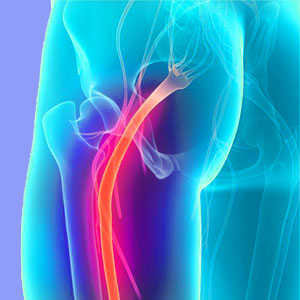
Welcome to our easy to use sciatica guide. This resource provides an outline of what every patient must do when seeking diagnosis and treatment for back and leg symptoms. We consistently receive letters from readers asking for a simple outline of what they should look out for when seeking professional care for sciatica. These patients want to know what type of doctor to see, what type of diagnostic testing they should receive and what type of treatment will work best to end their pain for good. Therefore, we have created this simple checklist of considerations for every patient to read when faced with severe sciatica pain.
This patient guide provides important ideas that every patient must know before seeking sciatica care. We will cover the basics of the condition, the diagnostic process and the treatment regimen so that patients can choose the best practices to fit their specific needs for pain relief. If you want the short version of this website, it is contained right in this sciatica guide.
Sciatica Guide to Causation and Symptoms
When faced with sciatica, it is crucial to understand what causes true spinally-motivated symptoms and what causes pseudo-sciatica pain. This is basic information that all patients must know in order to prevent diagnostic and treatment errors from occurring later on. We recommend that patients research how constriction of nerve structures can cause symptoms and why chronic pain is not typically an expression associated with continued neurological compression syndromes.
Symptoms of sciatica range from pain to tingling to numbness to weakness. There are subjective and objective versions of the later 2 symptomatic expressions. The sciatic nerve does not serve the back, but instead innervates the legs and feet, so this is where symptoms should exist. Symptoms may be wide-ranging in location, or in select parts of the leg or foot. Symptoms might change or be very consistent. Patients should study their symptoms and document them in order to assist their caregiver to ascertain the actual causation of suffering. Once again, patients must understand what types of symptoms can affect them with any type of sciatic nerve condition, in order to improve their chances of successful diagnosis and treatment later on.
Sciatica Diagnosis
The diagnostic process varies greatly depending on what type of doctor is consulted for care. Patients can choose from orthopedists, neurologists, general practitioners and physical therapists in the traditional medical realm. Patients can also choose from chiropractors and various types of therapists in the complementary medical realm. Since neurologists are nerve experts and virtually all sciatica syndromes are neurologically motivated, we recommend seeing a spinal neurologist as the most logical choice of diagnostician. It is usually best if their doctor is not a surgeon, since this dual role often influences treatment recommendations in favor of unnecessary surgery.
Regardless of what type of caregiver chosen, the diagnostic process should always include a detailed interview concerning the symptoms, including the expressions and locations these are experienced. The diagnostic process should also include a comprehensive physical exam, including a neurological exam. We often find both of these ideal inclusions sadly missing from many doctor consultations. If this mirrors your experience, your care provider might not be thorough enough to achieve an accurate diagnosis and we advise you to be wary.
Depending on the particulars of your pain history and time of onset, as well as the results of the above 2 parts of the diagnostic process, patients might also be subjected to various tests including x-ray imaging, CT or MRI imaging, nerve conduction testing, electromyography and other procedures.
Patients are strongly cautioned that many cases of sciatica are mistakenly diagnosed and linked to incidental and innocent spinal irregularities in the lumbar spine. This occurs despite the symptoms not correlating with clinical expectations, which is why it is so important to be an educated and knowledgeable patient. You must advocate for yourself and be responsible for understanding why a given diagnostic makes sense or not.
Sciatica Guide to Treatment
Depending on the diagnosis rendered, sciatica treatment may range from “none needed” to recommendations for the most invasive forms of surgery that are available in the back and neck pain industry. Since many factors go into the prescription for specific forms of treatment, we will use this section to comment generally on things to watch out for during the treatment process.
Conservative care is nonsurgical, but virtually never has any hope of actually providing a cure. There are very few exceptions to this rule. Most continuing care practices will only provide temporary and partial relief and must be continued indefinitely in order to continue to provide benefits. These practices include the most common symptomatic sciatica therapies, including drugs, chiropractic, massage, TENS, injections and virtually all other noninvasive methods of care. The exception to this rule is nonsurgical spinal decompression, which can be curative, but is only indicated for select and mostly disc-related causes of pain.
Surgical treatment for sciatica can usually be avoided and certainly should usually be avoided based on the overwhelmingly negative treatment statistics for all manner of procedures. When surgery is actually needed, it is always best to seek out the least invasive and least complicated procedure to fulfill the surgical objective. Surgery for sciatica demonstrates very poor curative outcome results over timelines of 7 years. However, since the results are really awful for some techniques, we actually consider a 7 year duration of partial relief to be a positive exception to the rule of worsened pain or no significant relief gained postoperatively by many patients.
Sciatica Guidance and Tips
At this point in reading, you should have more questions than answers. That is our whole purpose in writing this simple guide. After all, healthcare is not a simple topic and your health should never be risked by taking advice from a single watered-down article on a website. Instead, we highly recommend that you give up your quest for the “shortcut” and instead, immerse yourself in knowledge about sciatica, so that you are truly well prepared to face the trials and challenges of the coming diagnostic and treatment processes. We have made this easy for you, since this web resource is devoted to sciatica 100% and is the most comprehensive sciatica website anywhere. All you have to do is read. We prefer to cover each topic is complete detail, which is why the site is so large and well researched.
Please, take your time and read more of this website. All the information is free and there is no sales pitch. Enjoy this while it lasts, since once you seek professional care, the line between medicine and marketing will blur immediately. You are worth your own time and effort. Your health matters. Don’t look for the easy way out. Instead, arm yourself with a complete knowledge base so that you can converse with your doctor in an educated and well-informed manner. This is the final advice we give you. Learn, learn and learn more. We are here to help you. You just have to want to understand sciatica in order to improve your chances of beating it.





